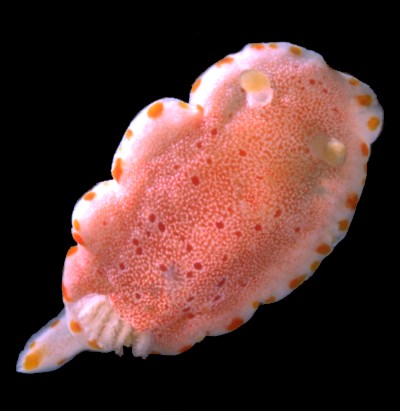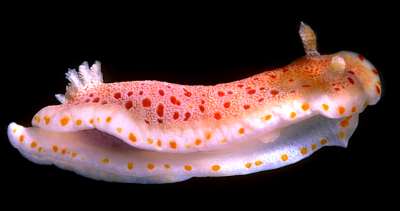

Chromodoris multimaculosa
Rudman, 1987
Order: NUDIBRANCHIA
Suborder: DORIDINA
Superfamily: EUDORIDOIDEA
Family: Chromodorididae
DISTRIBUTION
Known only from northern Tasmania
PHOTO
Sisters Island, N.W. Tasmania; 4 specimens, (14, 19, 22, 23 mm long alive), 10 m, 22 September 1985, AM C148085. Photo: Bill Rudman.
The mantle is elongately ovate and has a relatively wide overlap completely obscuring the foot. In most cases the mantle is translucent pinkish with a broad opaque white band around the edge formed from both subepithelial dendritic mantle glands and epidermal pigmentation. There is a row of relatively large orange spots just in from the edge. The rest of the mantle appears pink with fine white specks and an irregular scattering of bright red spots. In detail, this part of the mantle is translucent with aggregations of white specks forming a close reticulate pattern, the spaces in the reticulation having a fine dusting of bright red specks which, with the pale viscera showing through, give the mantle the pink background colour. Each of the larger red spots is in one of the spaces in the reticulate pattern and is therefore surrounded by a white ring.
The rhinophore stalk is transparent and the club straw-coloured, and both have some white speckling. The gills are also translucent with some white speckling. There are ten simple gills forming a circle around the anus. The foot and sides of the body are translucent white with some white speckling, and there is a submarginal row of orange spots around the foot including the anterior end.
Of a group of four animals collected together (AM C148085) the smallest differs from the rest in having no trace of red pigmentation, the mantle appearing a pale yellow-orange. In detail the mantle has white specks arranged in a reticulate pattern as in the pink specimens, but in the 'meshes' of the reticulation there are diffuse yellow-orange spots, some quite large but still smaller than the bright red spots of the 'typical' colour pattern. There is a whitish border to the mantle, but it is not clearly defined, and there are a series of yellow-orange spots around the edge. The sides of the body and foot are translucent with some white speckling and a submarginal row of yellow-orange spots around the edge of the foot. The posterior end of the foot is coloured as the mantle with white specks and small yellowish spots. There is a large yellow-orange spot on the posterior tip of the foot.
This species is known only from the seven specimens recorded here from Tasmania. There are other red-spotted or orange-spotted species of Chromodoris reported from Tasmania and from southeastern Australia. Chromodoris multimaculosa differs from most in having spots of ywo colours, although the orange only colour form has external similarities to Noumea closei. It differs from that species in the shape of the radular teeth and reproductve system.
- Rudman, W.B. (1986) The Chromodorididae (Opisthobranchia: Mollusca) of the Indo-West Pacific: Noumea flava colour group. Zoological Journal of the Linnean Society, 88: 377-404.
- Rudman,W.B.,(1987). The Chromodorididae (Opisthobranchia : Mollusca) of the Indo-West Pacific: Chromodoris epicuria, C. aureopurpurea, C. annulata, C. coi and Risbecia tryoni colour groups. Zoological Journal of the Linnean Society 90: 305-407.
Rudman, W.B., 2010 (May 29) Chromodoris multimaculosa Rudman, 1987. [In] Sea Slug Forum. Australian Museum, Sydney. Available from http://www.seaslugforum.net/factsheet/chromult
